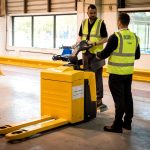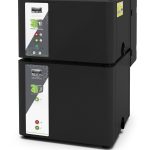 Unless weldable materials are relatively thin, edge preparation is usually necessary for achieving high-integrity welded joints. Depending on the joint design, this requires one or more beveled edges on one or both of the components. Types of bevel are named after the capital letters that look similar, the most common being V, X, Y and K. However, welding preparation is not the only reason for cutting bevels – another application example is countersinking Hardox plate for fixing with countersunk screws. Because of the extreme wear-resistance of Hardox, even costly carbide-tipped drills and countersinks have a limited life, so plasma beveling is an attractive alternative for producing countersunk holes.
Unless weldable materials are relatively thin, edge preparation is usually necessary for achieving high-integrity welded joints. Depending on the joint design, this requires one or more beveled edges on one or both of the components. Types of bevel are named after the capital letters that look similar, the most common being V, X, Y and K. However, welding preparation is not the only reason for cutting bevels – another application example is countersinking Hardox plate for fixing with countersunk screws. Because of the extreme wear-resistance of Hardox, even costly carbide-tipped drills and countersinks have a limited life, so plasma beveling is an attractive alternative for producing countersunk holes.
For weld preparation, the mild steel, high-alloy steel, stainless steel or aluminium alloy would be cut or profiled, then the bevel(s) applied afterwards. Plasma is popular for automated profiling today, particularly for materials ranging in thickness from 2 mm to 40 mm, due to the high cutting speed, excellent accuracy, clean cut with narrow kerf, low heat input (hence less distortion and a narrower heat-affected zone), and lower cost than laser or water-jet cutting. Having cut the profile, beveling has traditionally been undertaken as a secondary process, with manual grinding and bench bevellers commonly used. If an X or K beveled edge is required, the plate requires two passes.
However, there are two key problems with this approach: production inefficiencies and health and safety. If a secondary process is necessary for applying the bevel, the profiled components need to be removed from the cutting machine, transported to the secondary process and then beveled. All of this takes time and the secondary processing station requires valuable floor space. In terms of health and safety, the issues to be aware of are RSI (repetitive strain injury) when the same operation is being carried out repeatedly, and HAV (hand-arm vibration) from working with equipment that produces vibrations.
For several years there have been beveling options available for CNC plasma profiling machines, but these have often been relatively large and heavy, meaning they are only suitable for larger gantries. Furthermore, there have been issues over how collisions are dealt with. When cutting small components it is not unusual for the cut part to tip if it is not fully supported by the cutting table, resulting in a raised obstacle with which the cutting torch can collide. In order to protect the torch and machine from damage, the plasma cutting head is usually attached to the gantry via a breakaway device that allows the torch to move out of harm’s way when a collision occurs. Although this does, indeed, prevent damage from being sustained, the torch has to be reset. This might require an operative to climb on the machine to physically reset the torch, and an alignment procedure should be completed to ensure that the machine’s precision is not lost. This is time-consuming and not always completed so, while the accuracy for vertical profiling may be adequate, any positional errors are multiplied when cutting bevels, resulting in components being scrapped and time lost while replacements are cut and beveled.
Next-generation automated plasma beveling
Fortunately ESAB has revisited automated plasma beveling, applying 21st century technologies to develop a beveller that overcomes the shortcomings of previous generations of plasma beveller to provide substantial productivity improvements, avoid health and safety issues, and all at a price that is more affordable and suitable for use on small and medium-sized machines. A critical element of the recently introduced DMX (Direct Multi-aXis motion) system is the direct-drive servo motors that eliminate the toothed belts and gearing commonly employed in other plasma bevellers. The direct-drive servos help to minimize size and weight, meaning the DMX plasma beveller can be mounted on smaller machines, and integrated torque monitoring supports the collision-detection function; when a servo motor stalls (indicating that a collision has occurred) the electrical drive to the servo motors is cut, so the beveller’s axes are free to move. But the advantages of the servo technology go further than that because it also means the plasma beveller can be reset automatically without having to follow any lengthy, complex or time-consuming alignment procedure. The automatic reset also avoids the need for an operative to climb on the machine to reset a breakaway device.
In addition to the torque-sensing aspects of the Advanced Collision Sensing, there are further sensors that detect collisions with other parts of the bevel head to ensure that protection is provided against all types of collision on the table.
One of the restrictions with conventional plasma bevellers is the rotation, which is typically +/- 540°. In contrast, the direct-drive servo motors in the DMX system enable continuous rotation, which simplifies programming and saves time during cutting and beveling because there is no need to raise the torch, reset the rotation and then resume cutting.
With its compact design and direct-drive servo motors, the overall cutting head contains fewer moving parts than other plasma bevellers. This not only keeps purchasing costs lower, but also improves reliability. Another feature that enhances reliability is the robot-style torch lead sheath that protects the cables from snagging, heat and pierce spatter.
Simplified Programming
An important aspect of plasma beveling that we have not yet discussed is programming, and this is another reason why some end users have tended to shy away from beveling. With conventional systems it can become complex and time-consuming to program the beveling. ESAB has therefore developed SmartBevel technology and embedded it within its Columbus III CNC programming and nesting software package. SmartBevel not only simplifies the programming of beveling but is also saves time and reduces scrap by eliminating trial-and-error setups. Designed to support bevel cuts in accordance with AWS D1.1, SmartBevel implements best-practice bevel cutting sequences for V, X, Y and K bevels on mild steel ranging in thickness form 6 mm to 40 mm.
Currently the DMX beveller can be used with ESAB’s m3 plasma system but there will soon be an option to use it with iSeries plasma power sources for operation at up to 450 amps.
Clearly this 21st century approach to plasma beveling offers many advantages over traditional alternatives for both new machines and for retrofitting to existing Suprarex and Combirex machines. Nevertheless, there are applications for which the previous generation of plasma beveller is more appropriate. For example, if long cuts are required, such as for shipbuilding or wind tower production, ESAB’s Expert Pro benefits from a tactile foot that maintains tight control over the cutting height, and the Expert Pro can be used for cutting under water, which the DMX cannot.
Conclusion
For too long there has been a view held by some people that plasma beveling requires too much capital expenditure, is too difficult, impractical or does not deliver sufficient advantages to outweigh the drawbacks associated with complex programming, lengthy set-ups and time-consuming recovery from collisions. However, the DMX automated plasma beveller addresses all of these points, making beveling practical and cost-effective for new and existing CNC plasma cutting systems. To help customers maximize the benefits of their investment in plasma beveling, ESAB provides comprehensive service and support by telephone, email and in person. As well as technical support, the company provides preventative maintenance programs, plasma cutting consumables, advice on upgrades and retrofits, and operative training.
For readers still unsure about automated plasma beveling, ESAB has prepared a white paper ‘Plasma Beveling Technology – A discussion of productivity, costs and safety issues related to traditional and modern plasma bevel system designs’ that is available free of charge on request.




